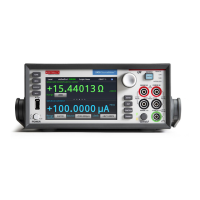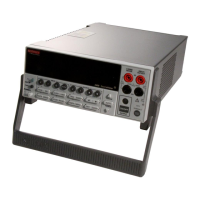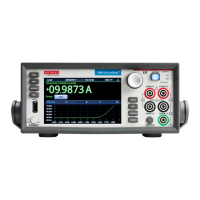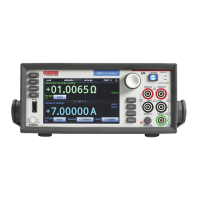Interactive SourceMeter® Instrument Reference Manual Section 5:
Introduction to SCPI commands
2450-901-01 Rev. B/September 2013 5-3
MINimum, MAXimum, and DEFault
You can use MINimum, MAXimum, or DEFault instead of a parameter for some commands.
For example, you can set <defaultParameter> for the command
[:SENSe[1]]:RESistance:NPLCycles <defaultParameter> to the minimum, maximum, or
default value. To set NPLC to the minimum value, you can send either of these commands:
:SENSe1:RESistance:NPLCycles MINimum
:SENS:RES:NPLC MIN
Queries
Some commands are queries and others have a query option. These commands have a question
mark (?) after the command. You can use the query to determine the present value of the parameters
of the command or to get information from the instrument.
For example, to determine what the present setting for NPLC is, you can send:
:SENSe1:RESistance:NPLCycles?
This query returns the present setting.
If the command has MINimum, MAXimum, and DEFault options, you can use the query command to
determine what the minimum, maximum, and default values are. In these queries, the ? is placed
before the MINimum, MAXimum, or DEFault parameter. For example, to determine the default value
for NPLC, you can send:
:SENSe1:RESistance:NPLCycles? DEFault
If you send two query commands without reading the response from the first, and then attempt to
read the second response, you may receive some data from the first response followed by the
complete second response. To avoid this, do not send a query command without reading the
response. When you cannot avoid this situation, send a device clear before sending the second query
command.
When you query a Boolean option, the instrument returns a 0 or 1, even if you sent OFF or ON when
you originally sent the command.
SCPI parameters
The parameters of the SCPI commands are shown in angle brackets (< >). For example:
:SYSTem:BEEPer[:IMMediate] <frequency>, <time>
The type of information that you can use to replace <frequency> and <time> is defined in the
Usage section of the command description. For this example, the Usage is:
The frequency of the beep (20 to 8000)
The amount of time to play the tone in seconds (0.001 to 100)
For this example, you can generate an audible sound by sending:
:SYSTem:BEEPer 500, 1
Note that you do not include the angle brackets when sending the command.

